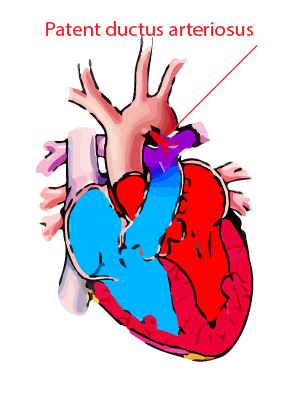Patent ductus arteriosus
Patent ductus arteriosus occurs when the developing ductus arteriosus does not close and persists as a shunt connecting the left branch of arteria pulmonalis and aorta, usually near the left subclavian.
The blood flows from the aorta through the ductus continuously in systole and diastole, it is a form of arteries venous fistulae in that way work of the left ventricle is increased. In some patients, obliterative changes in blood vessels in the lungs are leading to pulmonary hypertension. In that case, shunt is bi-directional or right-left.
The clinical picture of patent ductus arteriosus
Symptoms and signs of patent ductus arteriosus
There are no symptoms until a decompensation of left ventricle. The heart is in the normal range or easily increased with strong action at the top. A pulse pressure is wide and diastolic pressure is low. To the left, and on the edge of the sternum in the first intercostales space a continuous harsh murmur can be heard.
Thrill is common. If left ventricle is significant increase, then there is and paradoxical splitting of the second tone.
Radiographic findings of patent ductus arteriosus
The heart is normal in size and contour, but there can be increasing of the left atrium and left ventricle. Conspicuous protrusion of the aorta and the left atrium.
ECG of patent ductus arteriosus
Normal findings are signs of left ventricular enlargement, which depends on the width of the ductus.
Special tests for patent ductus arteriosus
With cardiac catheterization it is possible to establish the left-right shunt. The catheter can pass from pulmonary aorta through the ductus into the aorta, and with help of angiocardiography it is possible to exclude the presence of other defects (valsalva sinus rupture into the right heart), which produces a similar sound as the ductus arteriosus persistens.
Treatment for patent ductus arteriosus
In experienced hands, operative mortality is low (<1%), therefore it is advisable to close ductus. Operative mortality is higher in elderly patients. Therefore, surgical intervention should be advice carefully, particularly if the patients are asymptomatic and do not have left ventricular hypertrophy. The greatest risk is subacute bacterial endocarditis.
In case that there is pulmonary hypertension, an indication for ligation or cutting of patent ductus arteriosus is disputed, but the contemporary view goes in favor of ligation in all cases in which left right shunt is present, while pulmonary flow increases, the pressure in arteria pulmonalis is <100 mm Hg.
Prognosis for patent ductus arteriosus
Big shunts in early childhood can cause high mortality. Smaller shunts are compatible with long-life. The most common complication is congestive heart failure.
Also may occur and bacterial endocarditis. A small percentage of patients have pulmonary hypertension, therefore lower limbs, especially the toes are cyanotic (compared to the normal color of the fingers). In this condition the patient is not suitable for surgery.
You may also like:
- The Blalock Taussig shunt
The Blalock Taussig shunt is a temporary surgical operation that is performed on newborn babies. The Blalock Taussig shunt is done when the heart is not delivering enough blood enriched with oxygen to the rest of the body.
- Glenn shunt procedure and bidirectional Glenn shunt surgery
Glenn shunt is a temporary treatment that is applied on children (preceding the Fontan procedure) to improve blood flow to the lungs.
- Fontan procedure
The Fontan procedure is an open heart surgical procedure used in children with a defect in the structure of the heart and great vessels which are present at birth.



